串口分布
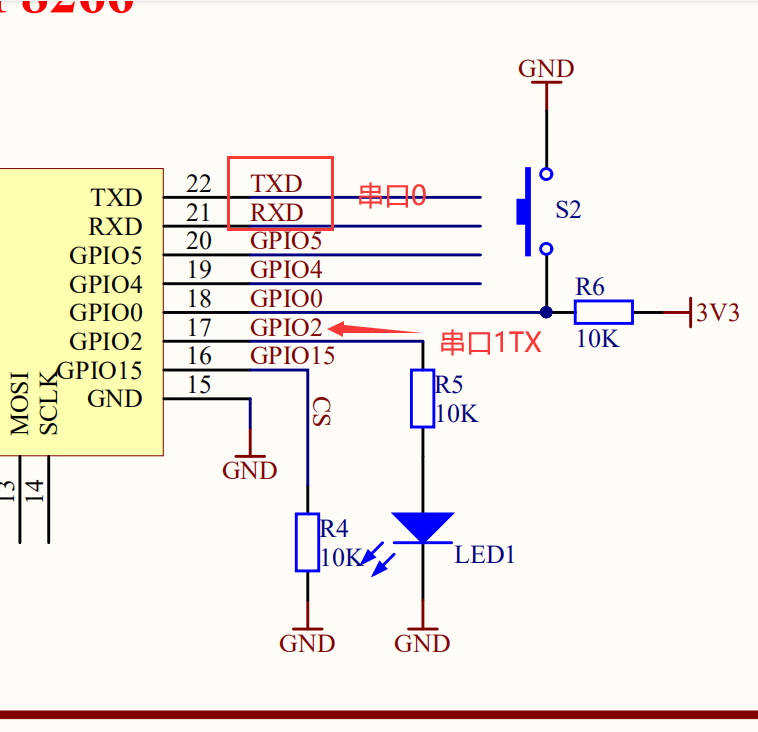
NONOS
NONOS
NONOS
1.配置串口
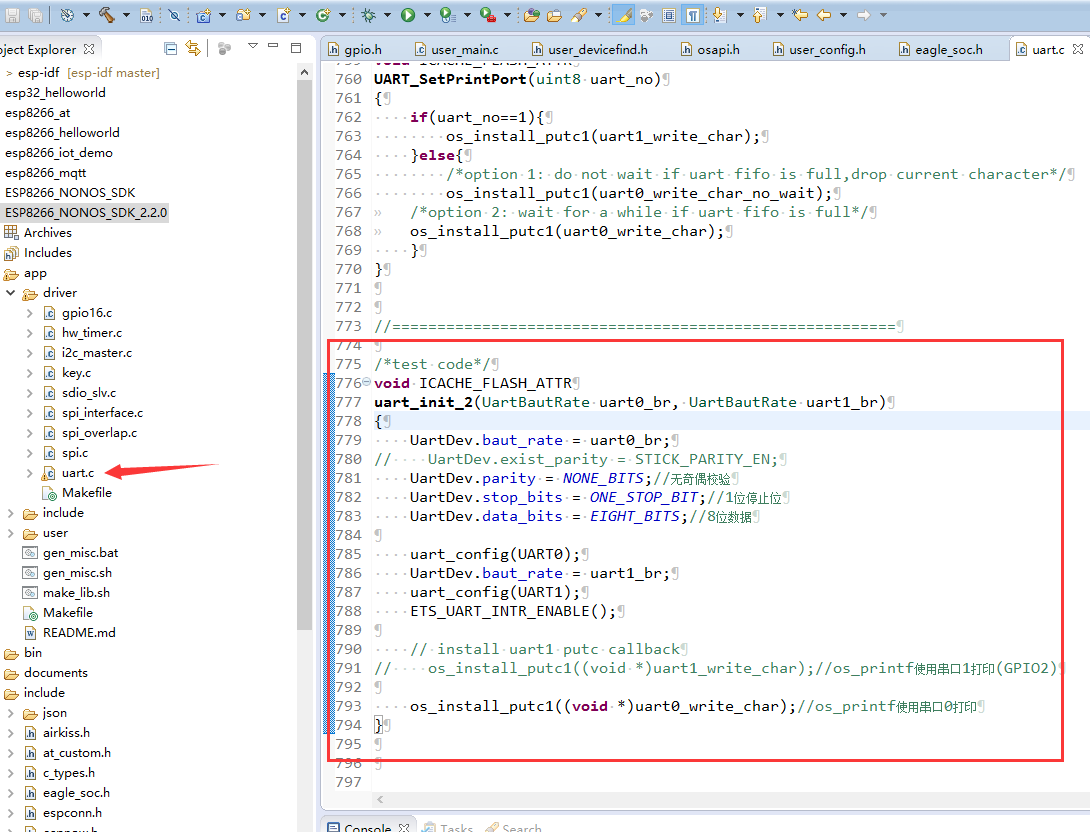
2.按照上面的配置以后,接收中断进入这里面

3.用户需要知道的事情
串口内部自带一个FIFO缓存,数据接收以后先缓存到内部FIFO缓存里面
内部FIFO满了以后进入FIFO满中断
串口打开了串口超时(空闲)中断:超过两个字节的时间没有接受到数据,进入串口超时(空闲)中断
接收思路:
如果进入满中断,在满中断中提取FIFO里面的数据
如果进入空闲中断,在空闲中断中提取FIFO里面的数据
无论怎样,程序最终都会进入空闲中断!
这节接收数据采用缓存
具体细节请参考:
https://www.cnblogs.com/yangfengwu/p/12770504.html
4.直接上菜
4.1创建缓存
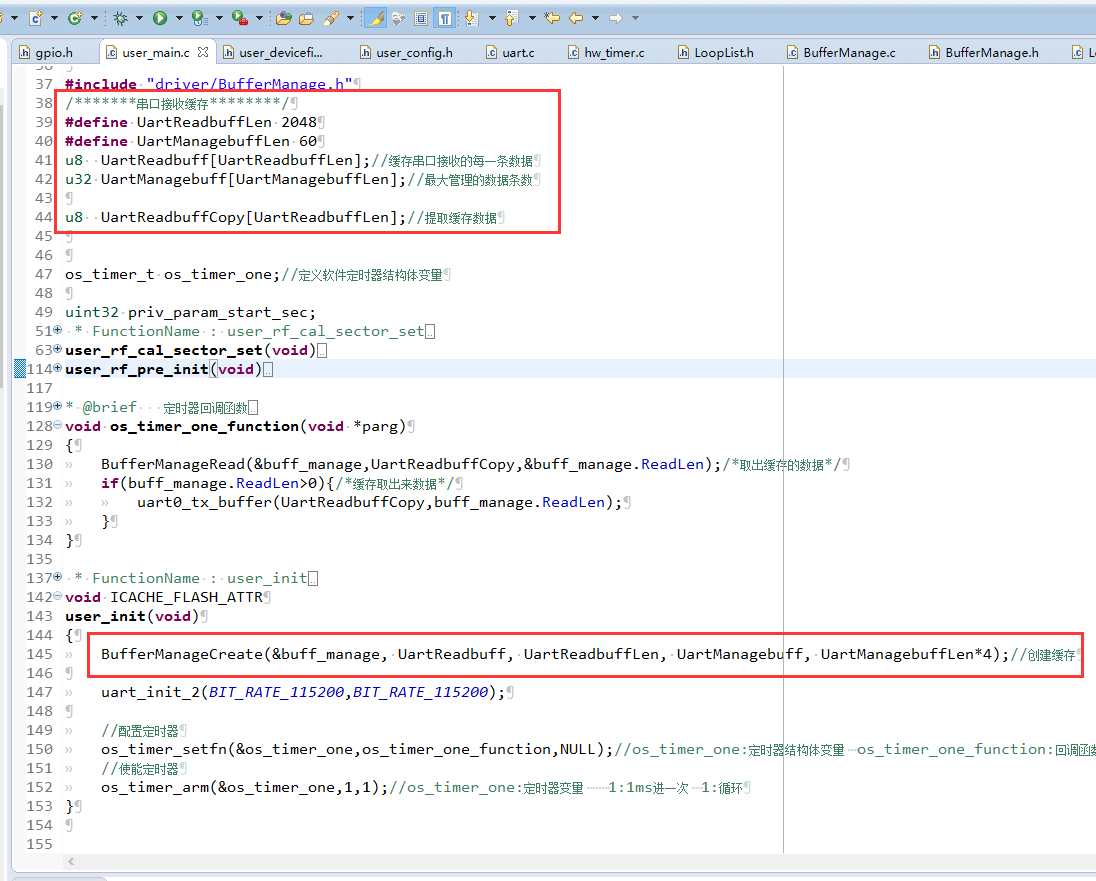
#include "driver/BufferManage.h" /*******串口接收缓存********/ #define UartReadbuffLen 2048 #define UartManagebuffLen 60 u8 UartReadbuff[UartReadbuffLen];//缓存串口接收的每一条数据 u32 UartManagebuff[UartManagebuffLen];//最大管理的数据条数 u8 UartReadbuffCopy[UartReadbuffLen];//提取缓存数据 BufferManageCreate(&buff_manage, UartReadbuff, UartReadbuffLen, UartManagebuff, UartManagebuffLen*4);//创建缓存
4.2往缓存里面存数据
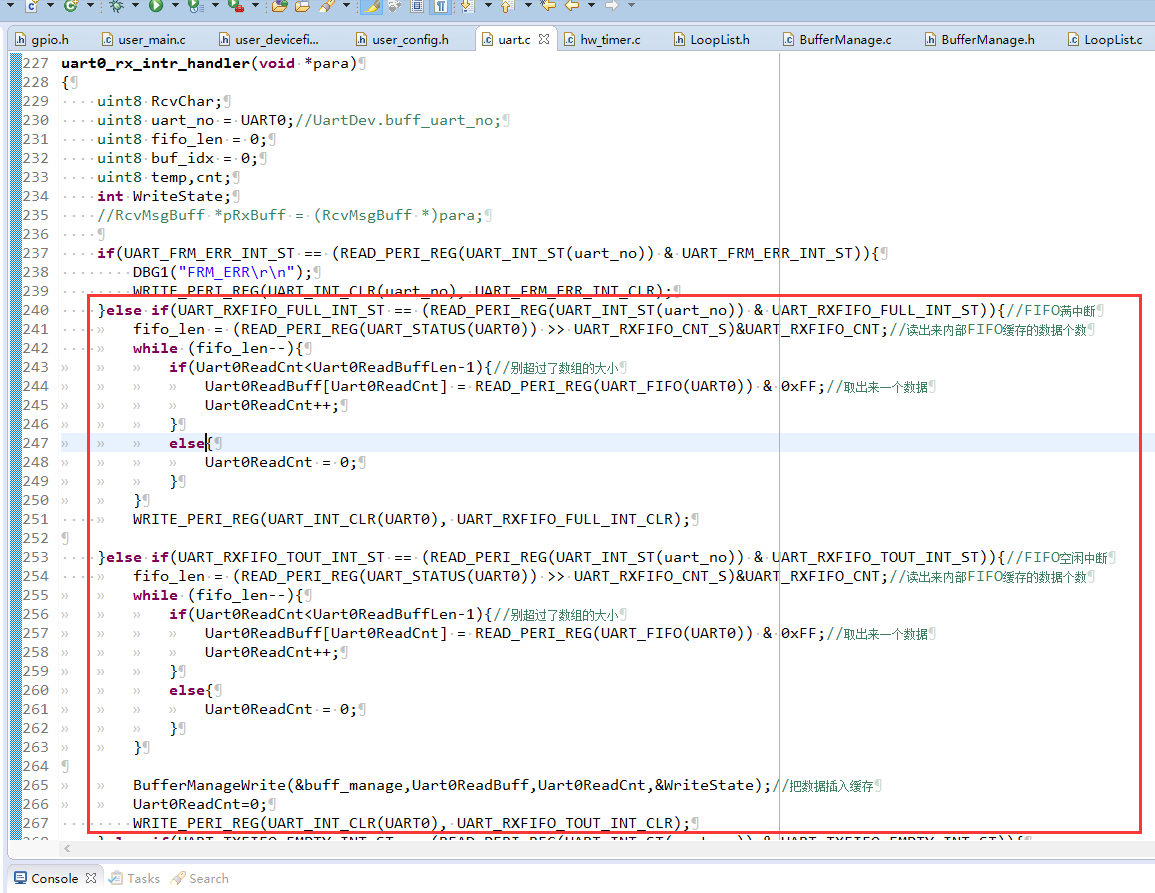
#include "driver/BufferManage.h" #define Uart0ReadBuffLen 2048 uint8 Uart0ReadBuff[Uart0ReadBuffLen];//串口一次性最大接收的数据个数 u32 Uart0ReadCnt=0; LOCAL void uart0_rx_intr_handler(void *para) { uint8 RcvChar; uint8 uart_no = UART0;//UartDev.buff_uart_no; uint8 fifo_len = 0; uint8 buf_idx = 0; uint8 temp,cnt; int WriteState; //RcvMsgBuff *pRxBuff = (RcvMsgBuff *)para; if(UART_FRM_ERR_INT_ST == (READ_PERI_REG(UART_INT_ST(uart_no)) & UART_FRM_ERR_INT_ST)){ DBG1("FRM_ERR "); WRITE_PERI_REG(UART_INT_CLR(uart_no), UART_FRM_ERR_INT_CLR); }else if(UART_RXFIFO_FULL_INT_ST == (READ_PERI_REG(UART_INT_ST(uart_no)) & UART_RXFIFO_FULL_INT_ST)){//FIFO满中断 fifo_len = (READ_PERI_REG(UART_STATUS(UART0)) >> UART_RXFIFO_CNT_S)&UART_RXFIFO_CNT;//读出来内部FIFO缓存的数据个数 while (fifo_len--){ if(Uart0ReadCnt<Uart0ReadBuffLen-1){//别超过了数组的大小 Uart0ReadBuff[Uart0ReadCnt] = READ_PERI_REG(UART_FIFO(UART0)) & 0xFF;//取出来一个数据 Uart0ReadCnt++; } else{ Uart0ReadCnt = 0; } } WRITE_PERI_REG(UART_INT_CLR(UART0), UART_RXFIFO_FULL_INT_CLR); }else if(UART_RXFIFO_TOUT_INT_ST == (READ_PERI_REG(UART_INT_ST(uart_no)) & UART_RXFIFO_TOUT_INT_ST)){//FIFO空闲中断 fifo_len = (READ_PERI_REG(UART_STATUS(UART0)) >> UART_RXFIFO_CNT_S)&UART_RXFIFO_CNT;//读出来内部FIFO缓存的数据个数 while (fifo_len--){ if(Uart0ReadCnt<Uart0ReadBuffLen-1){//别超过了数组的大小 Uart0ReadBuff[Uart0ReadCnt] = READ_PERI_REG(UART_FIFO(UART0)) & 0xFF;//取出来一个数据 Uart0ReadCnt++; } else{ Uart0ReadCnt = 0; } } BufferManageWrite(&buff_manage,Uart0ReadBuff,Uart0ReadCnt,&WriteState);//把数据插入缓存 Uart0ReadCnt=0; WRITE_PERI_REG(UART_INT_CLR(UART0), UART_RXFIFO_TOUT_INT_CLR); }else if(UART_TXFIFO_EMPTY_INT_ST == (READ_PERI_REG(UART_INT_ST(uart_no)) & UART_TXFIFO_EMPTY_INT_ST)){ DBG("e"); CLEAR_PERI_REG_MASK(UART_INT_ENA(UART0), UART_TXFIFO_EMPTY_INT_ENA); #if UART_BUFF_EN tx_start_uart_buffer(UART0); #endif //system_os_post(uart_recvTaskPrio, 1, 0); WRITE_PERI_REG(UART_INT_CLR(uart_no), UART_TXFIFO_EMPTY_INT_CLR); }else if(UART_RXFIFO_OVF_INT_ST == (READ_PERI_REG(UART_INT_ST(uart_no)) & UART_RXFIFO_OVF_INT_ST)){ WRITE_PERI_REG(UART_INT_CLR(uart_no), UART_RXFIFO_OVF_INT_CLR); DBG1("RX OVF!! "); } }
4.3提取缓存数据,并输出
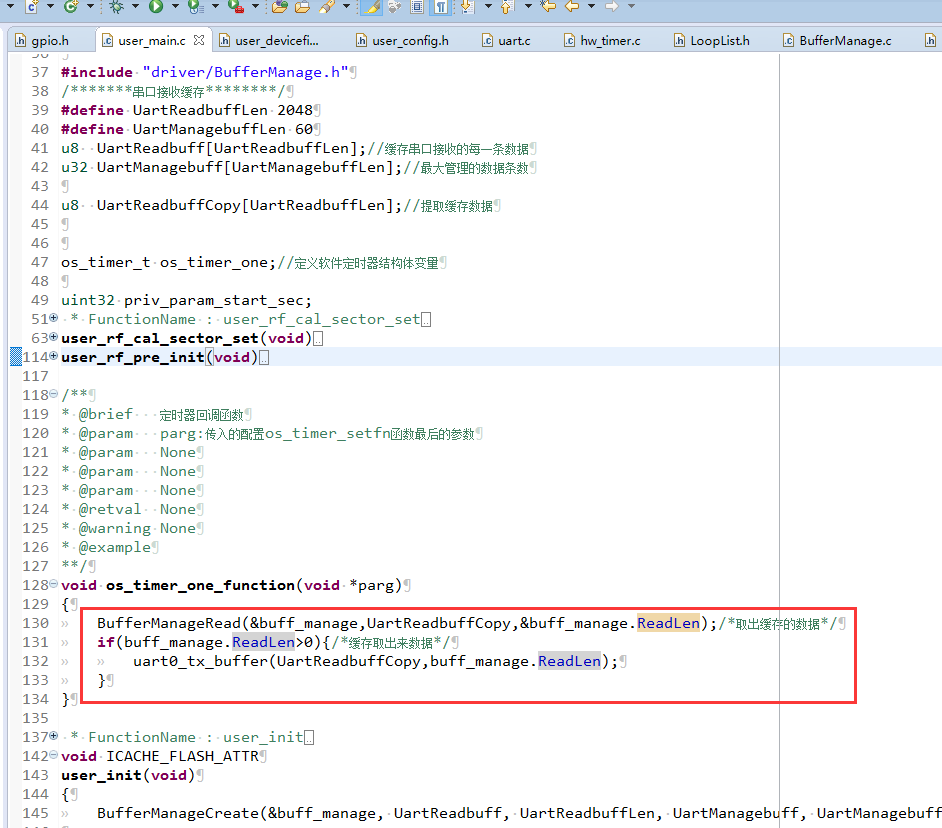
BufferManageRead(&buff_manage,UartReadbuffCopy,&buff_manage.ReadLen);/*取出缓存的数据*/ if(buff_manage.ReadLen>0){/*缓存取出来数据*/ uart0_tx_buffer(UartReadbuffCopy,buff_manage.ReadLen); }
测试
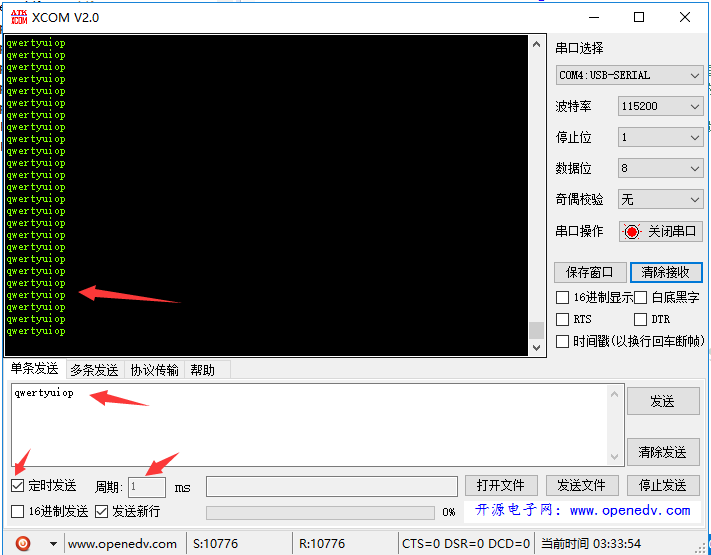
如果想应用到自己的项目,拷贝以下文件
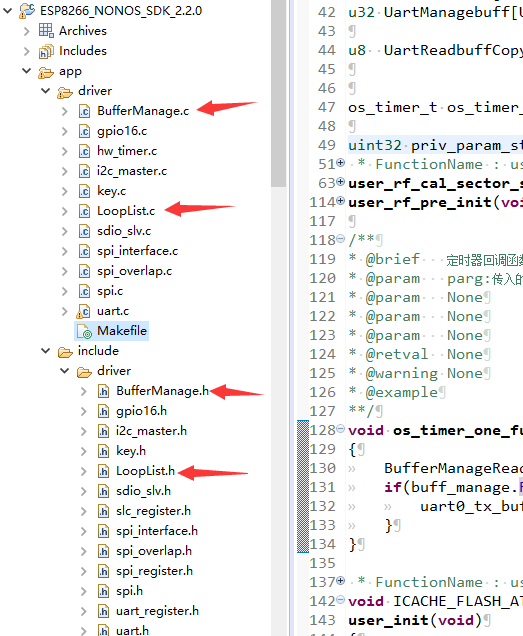
RTOS
RTOS
RTOS
1.默认所有的数据都使用串口0输出
官方提供了函数可以选择printf利用哪一个串口输出
配置printf使用串口1打印输出,波特率115200
(注:这样配置对于调试程序很有帮助,printf当做程序运行的日志打印)

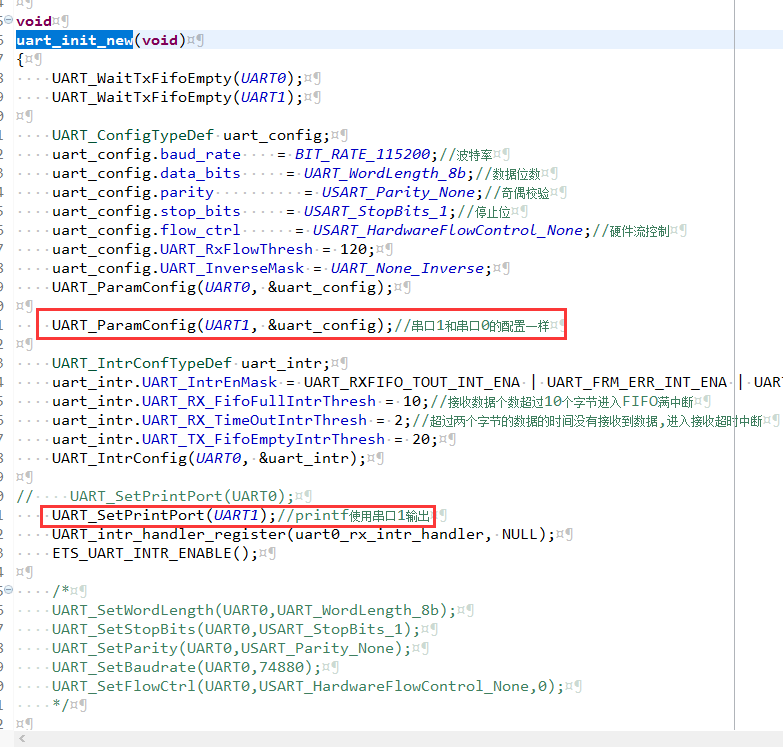
void uart_init_new(void) { UART_WaitTxFifoEmpty(UART0); UART_WaitTxFifoEmpty(UART1); UART_ConfigTypeDef uart_config; uart_config.baud_rate = BIT_RATE_115200;//波特率 uart_config.data_bits = UART_WordLength_8b;//数据位数 uart_config.parity = USART_Parity_None;//奇偶校验 uart_config.stop_bits = USART_StopBits_1;//停止位 uart_config.flow_ctrl = USART_HardwareFlowControl_None;//硬件流控制 uart_config.UART_RxFlowThresh = 120; uart_config.UART_InverseMask = UART_None_Inverse; UART_ParamConfig(UART0, &uart_config); UART_ParamConfig(UART1, &uart_config);//串口1和串口0的配置一样 UART_IntrConfTypeDef uart_intr; //配置启用哪些些中断 数据接收超时 接收数据错误 缓存满中断 发送空中断 uart_intr.UART_IntrEnMask = UART_RXFIFO_TOUT_INT_ENA | UART_FRM_ERR_INT_ENA | UART_RXFIFO_FULL_INT_ENA | UART_TXFIFO_EMPTY_INT_ENA; uart_intr.UART_RX_FifoFullIntrThresh = 10;//接收数据个数超过10个字节进入FIFO满中断 uart_intr.UART_RX_TimeOutIntrThresh = 2;//超过两个字节的数据的时间没有接收到数据,进入接收超时中断 uart_intr.UART_TX_FifoEmptyIntrThresh = 20; UART_IntrConfig(UART0, &uart_intr); // UART_SetPrintPort(UART0); UART_SetPrintPort(UART1);//printf使用串口1输出 UART_intr_handler_register(uart0_rx_intr_handler, NULL); ETS_UART_INTR_ENABLE(); /* UART_SetWordLength(UART0,UART_WordLength_8b); UART_SetStopBits(UART0,USART_StopBits_1); UART_SetParity(UART0,USART_Parity_None); UART_SetBaudrate(UART0,74880); UART_SetFlowCtrl(UART0,USART_HardwareFlowControl_None,0); */ }
串口接收数据说明
1.该模块默认内部有个128字节的缓存区,默认接收的数据存入缓存区里面
在中断接收函数里面,从缓存里面获取数据

2.咱们在串口中断函数里面,是在满中断和接收超时中断里面获取串口接收的数据

串口接收数据典型程序
1.具体请参考: https://www.cnblogs.com/yangfengwu/p/11669373.html
2.uart.c
//串口数据接收处理方式:https://www.cnblogs.com/yangfengwu/p/11669373.html char Usart0ReadBuff[Usart0ReadLen]={0};//接收数据缓存 u32 Usart0ReadCnt = 0;//串口接收的数据个数 u32 Usart0ReadCntCopy = 0;//用于拷贝串口接收的数据个数 u32 Usart0IdleCnt = 0;//空闲时间累加变量

LOCAL void uart0_rx_intr_handler(void *para) { uint8 RcvChar; uint8 uart_no = UART0;//UartDev.buff_uart_no; uint8 fifo_len = 0; uint8 buf_idx = 0; // uint8 fifo_tmp[128] = {0}; uint32 uart_intr_status = READ_PERI_REG(UART_INT_ST(uart_no)) ; while (uart_intr_status != 0x0) { if (UART_FRM_ERR_INT_ST == (uart_intr_status & UART_FRM_ERR_INT_ST)) {//数据错误 //printf("FRM_ERR "); WRITE_PERI_REG(UART_INT_CLR(uart_no), UART_FRM_ERR_INT_CLR); } else if (UART_RXFIFO_FULL_INT_ST == (uart_intr_status & UART_RXFIFO_FULL_INT_ST)) {//FIFO满中断 // printf("full "); fifo_len = (READ_PERI_REG(UART_STATUS(UART0)) >> UART_RXFIFO_CNT_S)&UART_RXFIFO_CNT;//读取缓存了多少字节 buf_idx = 0; while (buf_idx < fifo_len) { if(Usart0ReadCnt>Usart0ReadLen){//预防数组溢出 Usart0ReadCnt=0; } Usart0ReadBuff[Usart0ReadCnt] = READ_PERI_REG(UART_FIFO(UART0)) & 0xFF;//把数据存入数组 Usart0ReadCnt++; Usart0IdleCnt=0; // uart_tx_one_char(UART0, READ_PERI_REG(UART_FIFO(UART0)) & 0xFF);//从FIFO读取一字节数据并发送出去 buf_idx++; } WRITE_PERI_REG(UART_INT_CLR(UART0), UART_RXFIFO_FULL_INT_CLR); } else if (UART_RXFIFO_TOUT_INT_ST == (uart_intr_status & UART_RXFIFO_TOUT_INT_ST)) {//接收超时中断 // printf("tout "); fifo_len = (READ_PERI_REG(UART_STATUS(UART0)) >> UART_RXFIFO_CNT_S)&UART_RXFIFO_CNT;//读取缓存了多少字节 buf_idx = 0; while (buf_idx < fifo_len) { if(Usart0ReadCnt>Usart0ReadLen){//预防数组溢出 Usart0ReadCnt=0; } Usart0ReadBuff[Usart0ReadCnt] = READ_PERI_REG(UART_FIFO(UART0)) & 0xFF;//把数据存入数组 Usart0ReadCnt++; Usart0IdleCnt=0; // uart_tx_one_char(UART0, READ_PERI_REG(UART_FIFO(UART0)) & 0xFF);//从FIFO读取一字节数据并发送出去 buf_idx++; } WRITE_PERI_REG(UART_INT_CLR(UART0), UART_RXFIFO_TOUT_INT_CLR); } else if (UART_TXFIFO_EMPTY_INT_ST == (uart_intr_status & UART_TXFIFO_EMPTY_INT_ST)) {//发送缓存为空 // printf("empty "); WRITE_PERI_REG(UART_INT_CLR(uart_no), UART_TXFIFO_EMPTY_INT_CLR); CLEAR_PERI_REG_MASK(UART_INT_ENA(UART0), UART_TXFIFO_EMPTY_INT_ENA); } else { //skip } uart_intr_status = READ_PERI_REG(UART_INT_ST(uart_no)) ; } }

3.uart.h
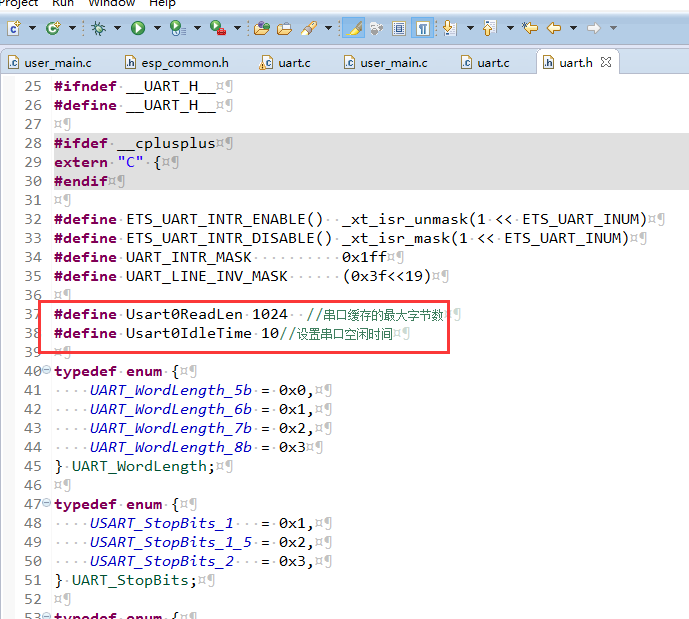
#define Usart0ReadLen 1024 //串口缓存的最大字节数 #define Usart0IdleTime 10//设置串口空闲时间
4.user_main.h

#include "uart.h" extern char Usart0ReadBuff[Usart0ReadLen];//接收数据缓存 extern u32 Usart0ReadCnt;//串口接收的数据个数 extern u32 Usart0ReadCntCopy;//用于拷贝串口接收的数据个数 extern u32 Usart0IdleCnt;//空闲时间累加变量
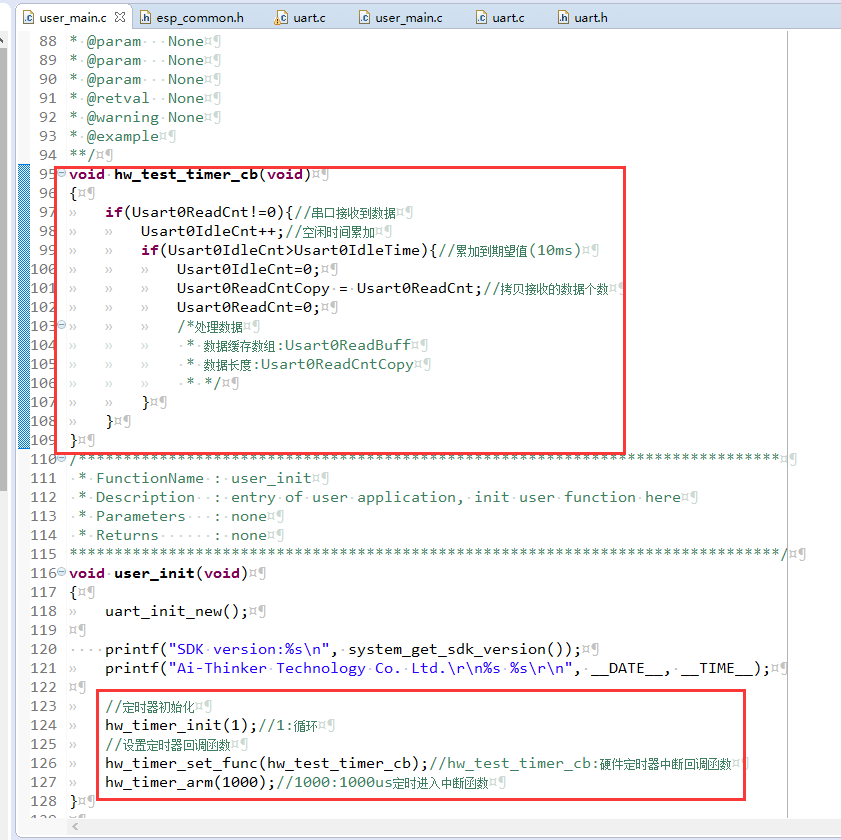
/** * @brief 硬件定时器中断回调函数 * @param None * @param None * @param None * @param None * @retval None * @warning None * @example **/ void hw_test_timer_cb(void) { if(Usart0ReadCnt!=0){//串口接收到数据 Usart0IdleCnt++;//空闲时间累加 if(Usart0IdleCnt>Usart0IdleTime){//累加到期望值(10ms) Usart0IdleCnt=0; Usart0ReadCntCopy = Usart0ReadCnt;//拷贝接收的数据个数 Usart0ReadCnt=0; /*处理数据 * 数据缓存数组:Usart0ReadBuff * 数据长度:Usart0ReadCntCopy * */ } } } /****************************************************************************** * FunctionName : user_init * Description : entry of user application, init user function here * Parameters : none * Returns : none *******************************************************************************/ void user_init(void) { uart_init_new(); printf("SDK version:%s ", system_get_sdk_version()); printf("Ai-Thinker Technology Co. Ltd. %s %s ", __DATE__, __TIME__); //定时器初始化 hw_timer_init(1);//1:循环 //设置定时器回调函数 hw_timer_set_func(hw_test_timer_cb);//hw_test_timer_cb:硬件定时器中断回调函数 hw_timer_arm(1000);//1000:1000us定时进入中断函数 }
串口发送
1.说明
串口发送实际上是把要发送的数据拷贝到128字节的数据发送缓存区
然后由模块内部发送
2.发送函数
3.为了可以在别的文件中使用,去掉函数前面的LOCAL 标识
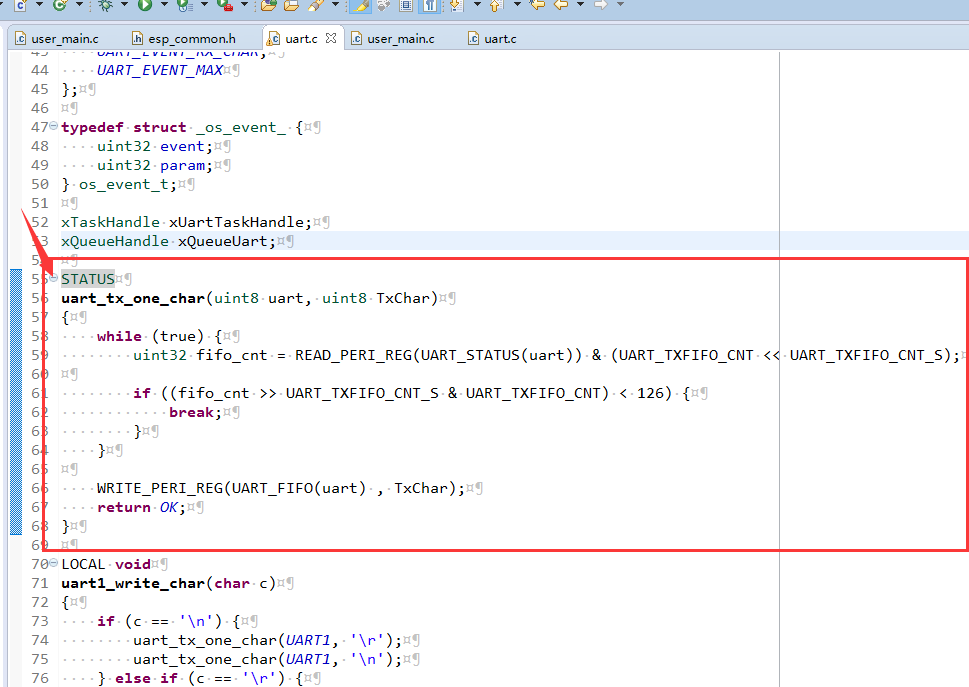
测试串口返回接收到的信息

/** * @brief 硬件定时器中断回调函数 * @param None * @param None * @param None * @param None * @retval None * @warning None * @example **/ void hw_test_timer_cb(void) { if(Usart0ReadCnt!=0){//串口接收到数据 Usart0IdleCnt++;//空闲时间累加 if(Usart0IdleCnt>Usart0IdleTime){//累加到期望值(10ms) Usart0IdleCnt=0; Usart0ReadCntCopy = Usart0ReadCnt;//拷贝接收的数据个数 Usart0ReadCnt=0; /*处理数据 * 数据缓存数组:Usart0ReadBuff * 数据长度:Usart0ReadCntCopy * */ for(i=0;i<Usart0ReadCntCopy;i++){ uart_tx_one_char(UART0,Usart0ReadBuff[i]); } } } }
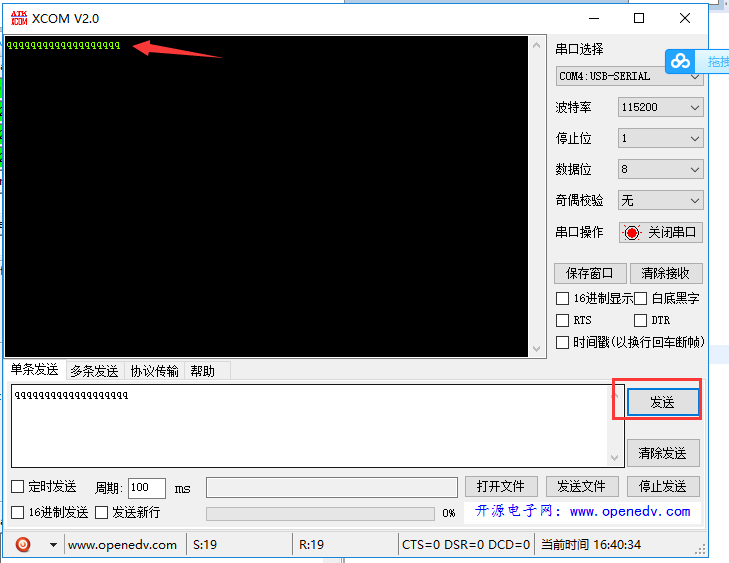
NONOS_SDK版本区别
NONOS提供了使用内部Task接收数据
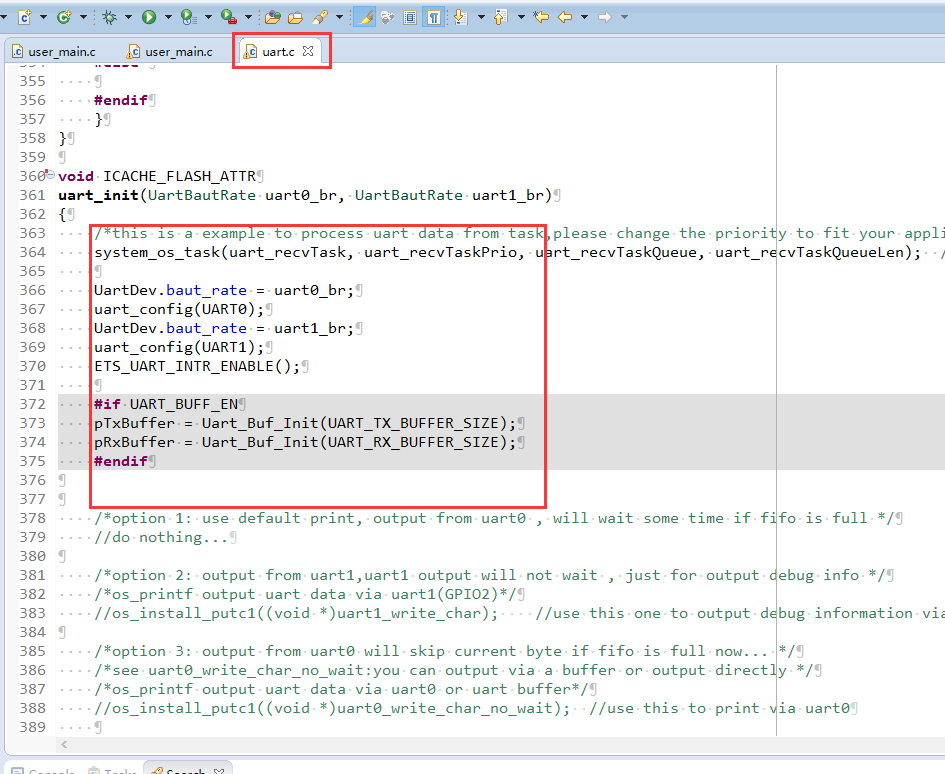
如果不想使用Task,想用上面的方式实现
在最后有一个 uart_init_2 可使用这个函数初始化串口
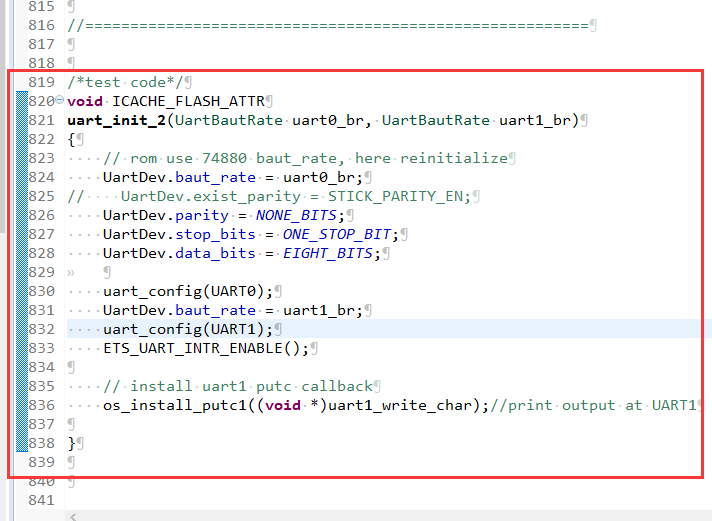
void ICACHE_FLASH_ATTR uart_init_2(UartBautRate uart0_br, UartBautRate uart1_br) { // rom use 74880 baut_rate, here reinitialize UartDev.baut_rate = uart0_br; // UartDev.exist_parity = STICK_PARITY_EN; UartDev.parity = NONE_BITS; UartDev.stop_bits = ONE_STOP_BIT; UartDev.data_bits = EIGHT_BITS; uart_config(UART0); UartDev.baut_rate = uart1_br; uart_config(UART1); ETS_UART_INTR_ENABLE(); // install uart1 putc callback os_install_putc1((void *)uart1_write_char);//print output at UART1 }
os_install_putc1((void *)uart0_write_char);//print output at UART0
